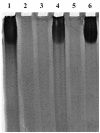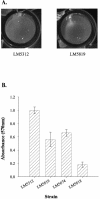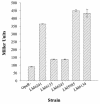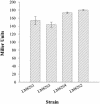Multiple regulators control capsular polysaccharide production in Vibrio parahaemolyticus
- PMID: 12949095
- PMCID: PMC193756
- DOI: 10.1128/JB.185.18.5431-5441.2003
Multiple regulators control capsular polysaccharide production in Vibrio parahaemolyticus
Abstract
Vibrio parahaemolyticus, a biofouling marine bacterium and human pathogen, undergoes phase variation displaying translucent (TR) and opaque (OP) colony morphologies. Prior studies demonstrated that OP colonies produce more capsular polysaccharide (CPS) than TR colonies and that opacity is controlled by the Vibrio harveyi LuxR-type transcriptional activator OpaR. CPS has also been shown to be regulated by the scrABC signaling pathway, which involves a GGDEF-EAL motif-containing sensory protein. The present study identifies cps genes and examines their regulation. Transposon insertions in the cps locus, which contains 11 genes, abolished opacity. Such mutants failed to produce CPS and were defective in pellicle formation in microtiter wells and in a biofilm attachment assay. Reporter fusions to cpsA, the first gene in the locus, showed approximately 10-fold-enhanced transcription in the OP (opaR+) strain compared to a TR (deltaopaR) strain. Two additional transcriptional regulators were discovered. One potential activator, CpsR, participates in the scrABC GGDEF-EAL-signaling pathway; CpsR was required for the increased cps expression observed in scrA deltaopaR strains. CpsR, which contains a conserved module found in members of the AAA+ superfamily of ATP-interacting proteins, is homologous to Vibrio cholerae VpsR; however, unlike VpsR, CpsR was not essential for cps expression. CpsS, the second newly identified regulator, contains a CsgD-type DNA-binding domain and appears to act as a repressor. Mutants with cpsS defects have greatly elevated cps transcription; their high level of cpsA expression was CpsR dependent in TR strains and primarily OpaR dependent in OP strains. Thus, a network of positive and negative regulators modulates CPS production in V. parahaemolyticus.
Figures









Similar articles
-
ScrG, a GGDEF-EAL protein, participates in regulating swarming and sticking in Vibrio parahaemolyticus.J Bacteriol. 2007 Jun;189(11):4094-107. doi: 10.1128/JB.01510-06. Epub 2007 Mar 30. J Bacteriol. 2007. PMID: 17400744 Free PMC article.
-
OpaR, a homolog of Vibrio harveyi LuxR, controls opacity of Vibrio parahaemolyticus.J Bacteriol. 1998 Jun;180(12):3166-73. doi: 10.1128/JB.180.12.3166-3173.1998. J Bacteriol. 1998. PMID: 9620967 Free PMC article.
-
QsvR and OpaR coordinately regulate the transcription of cpsS and cpsR in Vibrio parahaemolyticus.Can J Microbiol. 2024 Apr 1;70(4):128-134. doi: 10.1139/cjm-2023-0196. Epub 2024 Feb 28. Can J Microbiol. 2024. PMID: 38415613
-
Three new regulators of swarming in Vibrio parahaemolyticus.J Bacteriol. 2006 Apr;188(7):2625-35. doi: 10.1128/JB.188.7.2625-2635.2006. J Bacteriol. 2006. PMID: 16547050 Free PMC article.
-
Structure, Function, and Regulation of the Essential Virulence Factor Capsular Polysaccharide of Vibrio vulnificus.Int J Mol Sci. 2020 May 5;21(9):3259. doi: 10.3390/ijms21093259. Int J Mol Sci. 2020. PMID: 32380667 Free PMC article. Review.
Cited by
-
Vibrio owensii induces the tissue loss disease Montipora white syndrome in the Hawaiian reef coral Montipora capitata.PLoS One. 2012;7(10):e46717. doi: 10.1371/journal.pone.0046717. Epub 2012 Oct 8. PLoS One. 2012. PMID: 23056419 Free PMC article.
-
Genetic variation in the Vibrio vulnificus group 1 capsular polysaccharide operon.J Bacteriol. 2006 Mar;188(5):1987-98. doi: 10.1128/JB.188.5.1987-1998.2006. J Bacteriol. 2006. PMID: 16484211 Free PMC article.
-
Simultaneous Identification of Clinically Common Vibrio parahaemolyticus Serotypes Using Probe Melting Curve Analysis.Front Cell Infect Microbiol. 2019 Nov 14;9:385. doi: 10.3389/fcimb.2019.00385. eCollection 2019. Front Cell Infect Microbiol. 2019. PMID: 31799212 Free PMC article.
-
ScrG, a GGDEF-EAL protein, participates in regulating swarming and sticking in Vibrio parahaemolyticus.J Bacteriol. 2007 Jun;189(11):4094-107. doi: 10.1128/JB.01510-06. Epub 2007 Mar 30. J Bacteriol. 2007. PMID: 17400744 Free PMC article.
-
A tangled web: regulatory connections between quorum sensing and cyclic Di-GMP.J Bacteriol. 2012 Sep;194(17):4485-93. doi: 10.1128/JB.00379-12. Epub 2012 Jun 1. J Bacteriol. 2012. PMID: 22661686 Free PMC article. Review.
References
-
- Ausmees, N., R. Mayer, H. Weinhouse, G. Volman, D. Amikam, M. Benziman, and M. Lindberg. 2001. Genetic data indicate that proteins containing the GGDEF domain possess diguanylate cyclase activity. FEMS Microbiol. Lett. 204:163-167. - PubMed
Publication types
MeSH terms
Substances
Associated data
- Actions
- Actions
- Actions
LinkOut - more resources
Full Text Sources
Molecular Biology Databases
Miscellaneous

